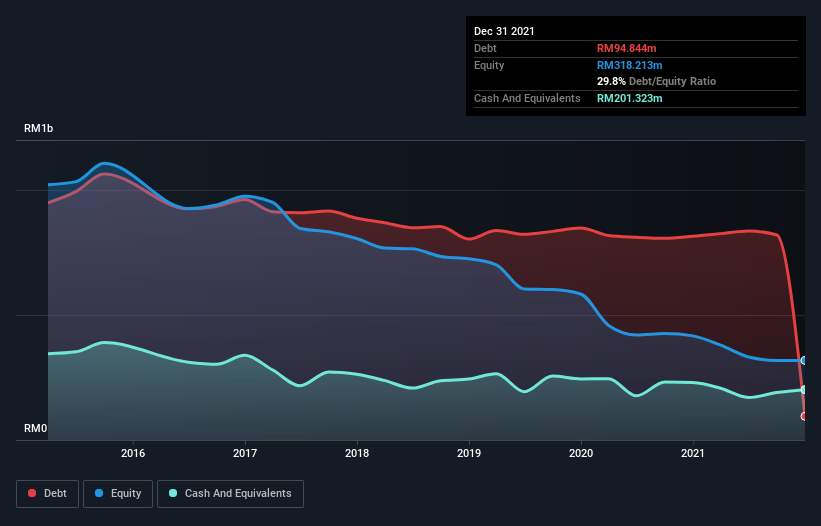- Malaysia
- /
- Industrials
- /
- KLSE:MUIIND
Is Malayan United Industries Berhad (KLSE:MUIIND) Using Debt Sensibly?

Legendary fund manager Li Lu (who Charlie Munger backed) once said, 'The biggest investment risk is not the volatility of prices, but whether you will suffer a permanent loss of capital.' It's only natural to consider a company's balance sheet when you examine how risky it is, since debt is often involved when a business collapses. We note that Malayan United Industries Berhad (KLSE:MUIIND) does have debt on its balance sheet. But should shareholders be worried about its use of debt?
Why Does Debt Bring Risk?
Generally speaking, debt only becomes a real problem when a company can't easily pay it off, either by raising capital or with its own cash flow. In the worst case scenario, a company can go bankrupt if it cannot pay its creditors. However, a more usual (but still expensive) situation is where a company must dilute shareholders at a cheap share price simply to get debt under control. Of course, plenty of companies use debt to fund growth, without any negative consequences. The first thing to do when considering how much debt a business uses is to look at its cash and debt together.
Check out our latest analysis for Malayan United Industries Berhad
What Is Malayan United Industries Berhad's Debt?
As you can see below, Malayan United Industries Berhad had RM94.8m of debt at December 2021, down from RM815.2m a year prior. However, it does have RM201.3m in cash offsetting this, leading to net cash of RM106.5m.

How Strong Is Malayan United Industries Berhad's Balance Sheet?
Zooming in on the latest balance sheet data, we can see that Malayan United Industries Berhad had liabilities of RM305.3m due within 12 months and liabilities of RM798.6m due beyond that. On the other hand, it had cash of RM201.3m and RM160.3m worth of receivables due within a year. So its liabilities total RM742.3m more than the combination of its cash and short-term receivables.
This deficit casts a shadow over the RM161.3m company, like a colossus towering over mere mortals. So we definitely think shareholders need to watch this one closely. At the end of the day, Malayan United Industries Berhad would probably need a major re-capitalization if its creditors were to demand repayment. Malayan United Industries Berhad boasts net cash, so it's fair to say it does not have a heavy debt load, even if it does have very significant liabilities, in total. There's no doubt that we learn most about debt from the balance sheet. But it is Malayan United Industries Berhad's earnings that will influence how the balance sheet holds up in the future. So when considering debt, it's definitely worth looking at the earnings trend. Click here for an interactive snapshot.
In the last year Malayan United Industries Berhad wasn't profitable at an EBIT level, but managed to grow its revenue by 15%, to RM221m. We usually like to see faster growth from unprofitable companies, but each to their own.
So How Risky Is Malayan United Industries Berhad?
Although Malayan United Industries Berhad had an earnings before interest and tax (EBIT) loss over the last twelve months, it generated positive free cash flow of RM32m. So taking that on face value, and considering the net cash situation, we don't think that the stock is too risky in the near term. We're not impressed by its revenue growth, so until we see some positive sustainable EBIT, we consider the stock to be high risk. The balance sheet is clearly the area to focus on when you are analysing debt. However, not all investment risk resides within the balance sheet - far from it. Case in point: We've spotted 3 warning signs for Malayan United Industries Berhad you should be aware of, and 1 of them is a bit concerning.
If you're interested in investing in businesses that can grow profits without the burden of debt, then check out this free list of growing businesses that have net cash on the balance sheet.
New: Manage All Your Stock Portfolios in One Place
We've created the ultimate portfolio companion for stock investors, and it's free.
• Connect an unlimited number of Portfolios and see your total in one currency
• Be alerted to new Warning Signs or Risks via email or mobile
• Track the Fair Value of your stocks
Have feedback on this article? Concerned about the content? Get in touch with us directly. Alternatively, email editorial-team (at) simplywallst.com.
This article by Simply Wall St is general in nature. We provide commentary based on historical data and analyst forecasts only using an unbiased methodology and our articles are not intended to be financial advice. It does not constitute a recommendation to buy or sell any stock, and does not take account of your objectives, or your financial situation. We aim to bring you long-term focused analysis driven by fundamental data. Note that our analysis may not factor in the latest price-sensitive company announcements or qualitative material. Simply Wall St has no position in any stocks mentioned.
About KLSE:MUIIND
Malayan United Industries Berhad
An investment holding company, primarily engages in the retailing, hotel, property, food, fast food chain, and financial service businesses in Malaysia, the Asia-Pacific, Australia, North America, and the United Kingdom.
Low and slightly overvalued.
Market Insights
Community Narratives



